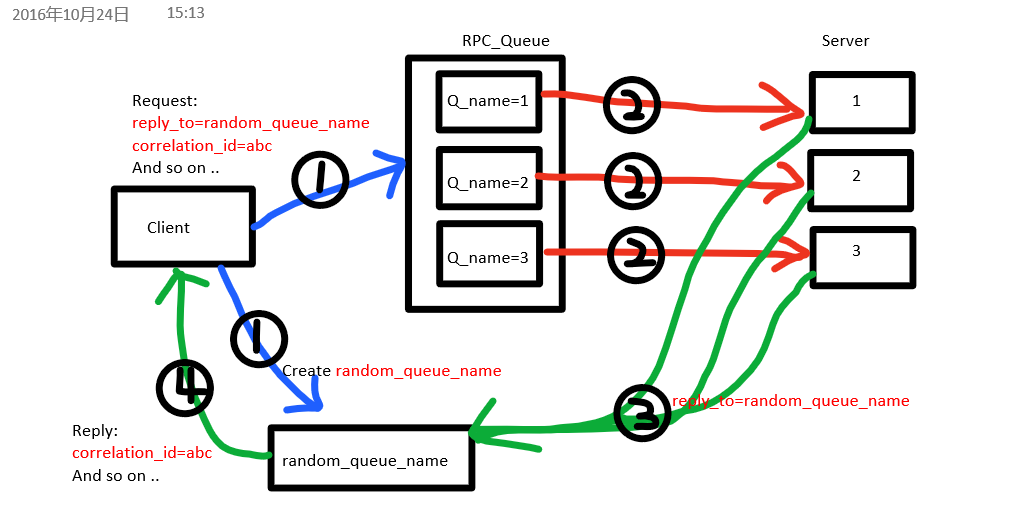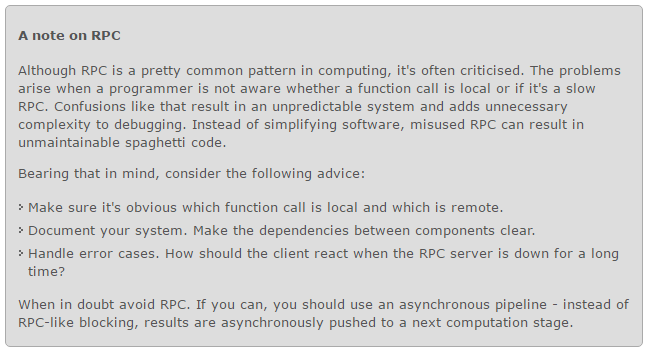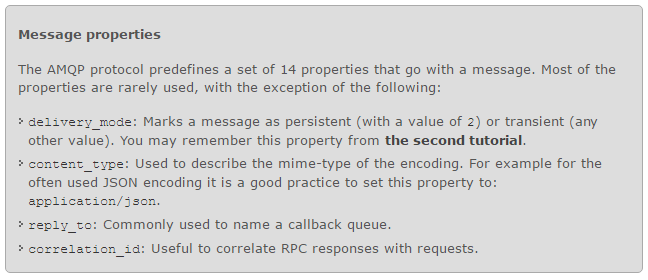Remote procedure call(RPC)
图解:
我们的RPC将会这样执行:
> 当客户端启动后,它创建一个随机的回调队列
> 对一个RPC请求,客户端发送一个消息包含两个属性:reply_to(用来设置回调队列)和 correlation_id(用来为每个请求设置一个唯一标识)
> 请求发送到RPC_Queue队列
> Server服务端监听RPC_Queue队列等待请求,当请求出现,服务端获取信息并将处理结果返回给客户端,使用reply_to字段中的队列
> 客户端在callback队列中等待数据,当一个消息出现后,检查这个correlation_id属性,如果和请求中的值匹配将返回给应用
Client端RPC_Client模块: Server端 |
###########################################################################################
以下摘自RabbitMQ官网内容:
Client interface
To illustrate how an RPC service could be used we're going to create a simple client class. It's going to expose a method named call which sends an RPC request and blocks until the answer is received:
fibonacci_rpc = FibonacciRpcClient()
result = fibonacci_rpc.call(4)
print("fib(4) is %r" % result)Callback queue
In general doing RPC over RabbitMQ is easy. A client sends a request message and a server replies with a response message. In order to receive a response the client needs to send a 'callback' queue address with the request. Let's try it:
result = channel.queue_declare(exclusive=True)
callback_queue = result.method.queue
channel.basic_publish(exchange='',
routing_key='rpc_queue',
properties=pika.BasicProperties(
reply_to = callback_queue,
),
body=request)
# ... and some code to read a response message from the callback_queue ...Correlation id
In the method presented above we suggest creating a callback queue for every RPC request. That's pretty inefficient, but fortunately there is a better way - let's create a single callback queue per client.
That raises a new issue, having received a response in that queue it's not clear to which request the response belongs. That's when the correlation_id property is used. We're going to set it to a unique value for every request. Later, when we receive a message in the callback queue we'll look at this property, and based on that we'll be able to match a response with a request. If we see an unknown correlation_id value, we may safely discard the message - it doesn't belong to our requests.
You may ask, why should we ignore unknown messages in the callback queue, rather than failing with an error? It's due to a possibility of a race condition on the server side. Although unlikely, it is possible that the RPC server will die just after sending us the answer, but before sending an acknowledgment message for the request. If that happens, the restarted RPC server will process the request again. That's why on the client we must handle the duplicate responses gracefully, and the RPC should ideally be idempotent.
Summary

Our RPC will work like this:
>When the Client starts up, it creates an anonymous exclusive callback queue.
>For an RPC request, the Client sends a message with two properties: reply_to, which is set to the callback queue and correlation_id, which is set to a unique value for every request.
>The request is sent to an rpc_queue queue.
>The RPC worker (aka: server) is waiting for requests on that queue. When a request appears, it does the job and sends a message with the result back to the Client, using the queue from the reply_to field.
>The client waits for data on the callback queue. When a message appears, it checks the correlation_id property. If it matches the value from the request it returns the response to the application.
Putting it all together
The code for rpc_server.py:
#!/usr/bin/env python
import pika
connection = pika.BlockingConnection(pika.ConnectionParameters(host='localhost'))
channel = connection.channel()
channel.queue_declare(queue='rpc_queue')
def fib(n):
if n == 0:
return 0
elif n == 1:
return 1
else:
return fib(n-1) + fib(n-2)
def on_request(ch, method, props, body):
n = int(body)
print(" [.] fib(%s)" % n)
response = fib(n)
ch.basic_publish(exchange='',
routing_key=props.reply_to,
properties=pika.BasicProperties(correlation_id = \
props.correlation_id),
body=str(response))
ch.basic_ack(delivery_tag = method.delivery_tag)
channel.basic_qos(prefetch_count=1)
channel.basic_consume(on_request, queue='rpc_queue')
print(" [x] Awaiting RPC requests")
channel.start_consuming()The server code is rather straightforward:
>(4) As usual we start by establishing the connection and declaring the queue.
>(11) We declare our fibonacci function. It assumes only valid positive integer input. (Don't expect this one to work for big numbers, it's probably the slowest recursive implementation possible).
>(19) We declare a callback for basic_consume, the core of the RPC server. It's executed when the request is received. It does the work and sends the response back.
>(32) We might want to run more than one server process. In order to spread the load equally over multiple servers we need to set the prefetch_count setting.
The code for rpc_client.py:
#!/usr/bin/env python
import pika
import uuid
class FibonacciRpcClient(object):
def __init__(self):
self.connection = pika.BlockingConnection(pika.ConnectionParameters(
host='localhost'))
self.channel = self.connection.channel()
result = self.channel.queue_declare(exclusive=True)
self.callback_queue = result.method.queue
self.channel.basic_consume(self.on_response, no_ack=True,
queue=self.callback_queue)
def on_response(self, ch, method, props, body):
if self.corr_id == props.correlation_id:
self.response = body
def call(self, n):
self.response = None
self.corr_id = str(uuid.uuid4())
self.channel.basic_publish(exchange='',
routing_key='rpc_queue',
properties=pika.BasicProperties(
reply_to = self.callback_queue,
correlation_id = self.corr_id,
),
body=str(n))
while self.response is None:
self.connection.process_data_events()
return int(self.response)
fibonacci_rpc = FibonacciRpcClient()
print(" [x] Requesting fib(30)")
response = fibonacci_rpc.call(30)
print(" [.] Got %r" % response)The client code is slightly more involved:
>(7) We establish a connection, channel and declare an exclusive 'callback' queue for replies.
>(16) We subscribe to the 'callback' queue, so that we can receive RPC responses.
>(18) The 'on_response' callback executed on every response is doing a very simple job, for every response message it checks if the correlation_id is the one we're looking for. If so, it saves the response in self.response and breaks the consuming loop.
>(23) Next, we define our main call method - it does the actual RPC request.
>(24) In this method, first we generate a unique correlation_id number and save it - the 'on_response' callback function will use this value to catch the appropriate response.
>(25) Next, we publish the request message, with two properties: reply_to and correlation_id.
>(32) At this point we can sit back and wait until the proper response arrives.
>(33) And finally we return the response back to the user.
Our RPC service is now ready. We can start the server:
$ python rpc_server.py
[x] Awaiting RPC requestsTo request a fibonacci number run the client:
$ python rpc_client.py
[x] Requesting fib(30)The presented design is not the only possible implementation of a RPC service, but it has some important advantages:
>If the RPC server is too slow, you can scale up by just running another one. Try running a second rpc_server.py in a new console.
>On the client side, the RPC requires sending and receiving only one message. No synchronous calls like queue_declare are required. As a result the RPC client needs only one network round trip for a single RPC request.
Our code is still pretty simplistic and doesn't try to solve more complex (but important) problems, like:
>How should the client react if there are no servers running?
>Should a client have some kind of timeout for the RPC?
>If the server malfunctions and raises an exception, should it be forwarded to the client?
>Protecting against invalid incoming messages (eg checking bounds) before processing.
链接地址(官网):http://www.rabbitmq.com/tutorials/tutorial-six-python.html
链接地址(翻译):http://blog.csdn.net/songfreeman/article/details/50951065
转载于:https://blog.51cto.com/cuzihate/1865052
























 196
196











 被折叠的 条评论
为什么被折叠?
被折叠的 条评论
为什么被折叠?








